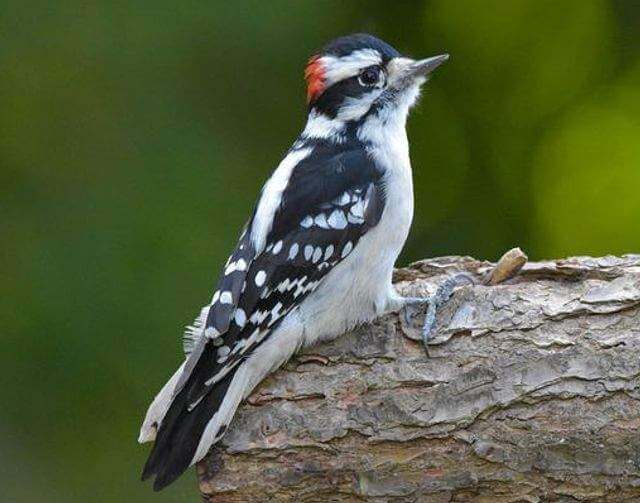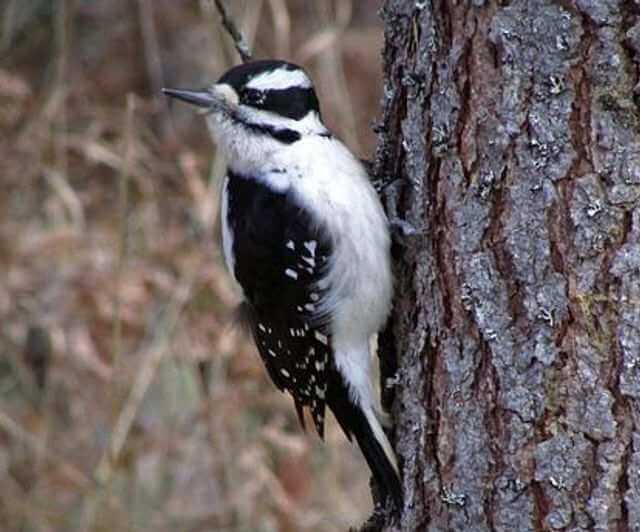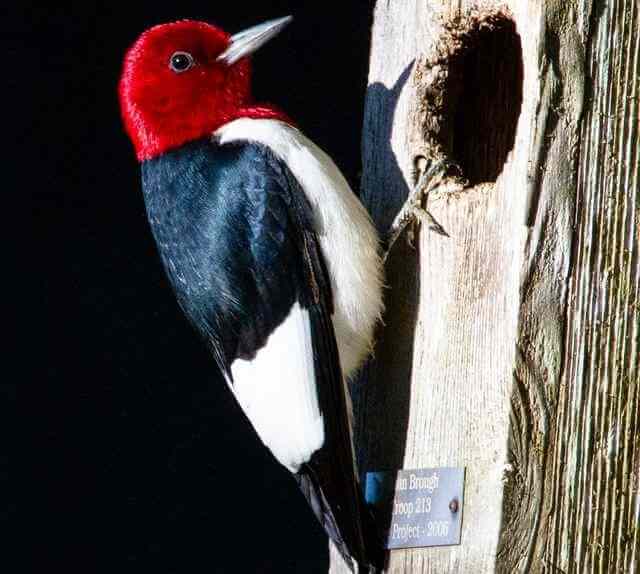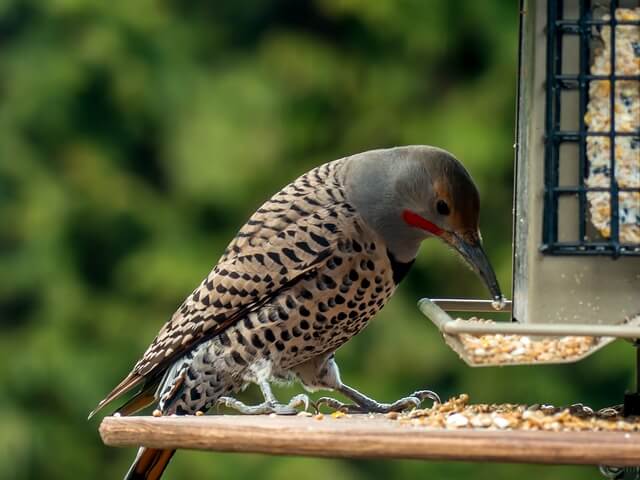Welcome to our comprehensive guide on the 8 types of woodpeckers found in Maryland! Woodpeckers are captivating birds known for their drumming and pecking behaviors.
In this ultimate guide, we’ll dive into the various species of woodpeckers native to Maryland, exploring their unique characteristics, habitats, and behaviors.
Whether you’re a birdwatcher, nature enthusiast, or simply intrigued by Maryland’s wildlife, this guide is your ultimate resource for learning about these remarkable birds.
Table of Contents
Types of Woodpeckers in Maryland
Red-bellied Woodpecker

- Length: 9.5 in (24 cm)
- Weight: 2.0-3.2 oz. (56-90 g)
- Wingspan: 13.0-16.5 in (33-42 cm)
- Scientific Name: Melanerpes carolinus
- Frequency of Occurrence: 38.59% (Statistic by: eBird)
- Where To Find Them: Red-bellied Woodpecker populations have been increasing in Maryland, where they can now be found at a few locations in the northeastern part of the state. The bird is most commonly seen around Baltimore and Harford counties, but it has also been spotted around Cumberland and Cecil counties.
- How to Attract: There are a few things you can do to attract them to your yard: feed them food, place bird feeders with nuts or black-oil sunflower seeds near trees, and install a birdbath.
Description: The Red-bellied Woodpecker is a common bird in the eastern United States. It ranges from New Hampshire to Florida, and from Missouri to Texas. The woodpecker is most common in the Appalachian Mountains, but it can also be found in the Ozarks and other parts of the Midwest.
The red-bellied woodpecker prefers trees with thick bark and lots of insects. Its diet consists mainly of insects, but it will also eat small birds eggs, fruits, nuts and seeds. These birds create new cavity nests each year in dead trees. The female lays from four to six eggs that are incubated by both sexes equally.
Related Post: How to Attract Red-bellied Woodpeckers to your Yard?
Downy Woodpecker

- Length: 5.5-6.7 in (14-17 cm)
- Weight: 0.7-1.0 oz. (21-28 g)
- Wingspan: 9.8-11.8 in (25-30 cm)
- Scientific Name: Picoides pubescens
- Frequency of Occurrence: 34.81%
- Where To Find Them: The Downy Woodpecker is a common sight in Maryland. They can be found in many locations, but some of the best spots include Blue Hills Forest and Wye Mills Wildlife Preserve.
- How to Attract: Install bird feeders that have a variety of foods, including nuts, seeds, and berries. Make sure the feeder is close to trees or other high-hangout spots. If you want to attract this bird to your yard, some key food sources include worms, grubs, cracked corn, and suet. Also provide perches suitable for the birds, such as wire poles or tall tree branches.
Description: The Downy Woodpecker is a bird that lives in North America. It has a distribution range that spans from the eastern coast of Canada all the way down to Florida and west to Texas. The Downy Woodpecker is found mostly in forests, but it can also be found in parks and other open areas. The Downy Woodpecker’s habitat consists of trees with plenty of branches and holes for nesting.
The Downy Woodpecker eats insects, such as beetles, ants, spiders, and other small things that it finds on the ground or in trees. During the spring and summer months, the downy woodpecker creates a nest by excavating a cavity in a dead tree up to 50 feet in the high.
Related Post: How to Attract Downy Woodpeckers to Your Yard? (Easy!)
Northern Flicker
- Length: 11.0-12.0 in (28-31 cm)
- Weight: 3.9-5.6 oz. (110-160 g)
- Wingspan: 16.5-20.0 in (42-51 cm)
- Scientific Name: Colaptes auratus
- Frequency of Occurrence: 20.36%
- Where To Find Them: The Northern Flicker is a common bird in Maryland. The flicker can be seen in many locations around the state, but some of the best spots to see this bird are at Fort McHenry National Monument and on the campuses of Towson University and Johns Hopkins University.
- How To Attract: Feed a mix of insects, such as worms, crickets, and mealworms. These critters will provide the bird with plenty of protein and other important nutrients it needs to thrive. Offer fresh fruits and vegetables – these items are high in vitamins, minerals, and other essential nutrients that help keep Northern Flickers healthy. Include varieties like strawberries, raspberries, and peas in your offerings for added excitement. Provide water dishes – these birds need plenty of fluids to stay hydrated during hot weather conditions. Include a dish large enough for several birds
Description: The Northern Flicker is a migratory bird that can be found in the United States and Canada. The Northern Flicker has a distribution range of nearly 2 million square miles which includes most of the eastern half of North America. The Northern Flicker prefers woodlands, with a preference for areas with many trees and long dead vegetation.
The Northern Flicker feeds mostly on insects, such as beetles, and ants, although it will also consume fruits and seeds. The Northern Flicker nests in tree cavities or tunnels, typically laying five to eight eggs.
Related Post: How to Attract Northern Flickers to your Backyard (Easy)
Pileated Woodpecker

- Length: 15.8-19.3 in (40-49 cm)
- Weight: 8.8-12.3 oz. (250-350 g)
- Wingspan: 26.0-29.5 in (66-75 cm)
- Scientific Name: Dryocopus pileatus
- Frequency of Occurrence: 12.78%
- Where To Find Them: They are most commonly seen in the Appalachian Mountains and in the Shenandoah Valley, but they have been seen as far north as Frederick County and as far south as Harford County.
- How To Attract: Install bird feeders throughout your yard. This will give the pileated woodpecker plenty of areas to forage for food. Try to create habitats that resemble those found in the natural environment. This can include creating a small grove of trees or shrubs, putting up a fence or wall of plants, and installing water features.
Description: The Pileated Woodpecker is a large woodpecker that can be found in many parts of North America. It has a distribution range that extends from southern Canada to central Mexico and from the eastern United States to western Panama. The Pileated Woodpecker inhabits deciduous and mixed forests, but is also found in open areas near water.
Its diet consists mainly of insects, such as ants, beetle larvae but it will also eat fruits and nuts. The Pileated Woodpecker nests in cavities in trees, but sometimes constructs its own nest using sticks and mud.
Related Post: How to Attract Pileated Woodpeckers to your Yard (Fast)
Hairy Woodpecker

- Length: 7.1-10.2 in (18-26 cm)
- Weight: 1.4-3.4 oz. (40-95 g)
- Wingspan: 13.0-16.1 in (33-41 cm)
- Scientific Name: Picoides villosus
- Frequency of Occurrence: 9.05%
- Where To Find Them: They can be found in many locations throughout the state, but some of the best spots to see them are in the George Washington National Forest and on the Eastern Shore.
- How To Attract: Plant plenty of trees and shrubs in your yard. This will provide plenty of nesting areas for the hairy woodpeckers, as well as food sources. Install bird feeders in strategic locations around your property. This will provide the birds with a steady supply of food, which they will appreciate. Make sure your yard is well-maintained – including clearing any debris that may be hiding nests or food sources.
Description: The Hairy Woodpecker is a medium-sized woodpecker that can be found in the eastern and central United States. It has a distribution range that includes most of the lower 48 states and parts of Canada. The habitat of the Hairy Woodpecker includes forests, woodlands, and other wooded areas.
The diet of the Hairy Woodpecker includes insects, spiders, and other small creatures. They also eat fruit when available. The female will excavate a hole in a tree to build her nest, and lay her eggs. After laying the eggs, she will incubate them for about 14 days. Then she will hatchlings will fledge and leave the nest.
Yellow-bellied Sapsucker

- Length: 7.1-8.7 in (18-22 cm)
- Weight: 1.5-1.9 oz. (43-55 g)
- Wingspan: 13.4-15.8 in (34-40 cm)
- Scientific Name: Sphyrapicus varius
- Frequency of Occurrence: 4.35%
- Where To Find Them: The Yellow-bellied Sapsucker can be found in a few locations in Maryland, but some of the more popular spots are Catonsville Wildlife Area, Savage River State Park and Forest Hill Wildlife Preserve.
- How to Attract: This bird is not shy and will come to close to people in order to feed. The best way to attract this bird to your yard is by providing plenty of food sources. You can also try planting trees that are good for the sapsucker, such as oaks or maples.
Description: The Yellow-bellied Sapsucker, a widespread bird that can be found in nearly every state in the U.S. The yellow-bellies are restricted to the Appalachian Mountains and adjacent portions of the Ozark and Ouachita Mountains of Arkansas, Louisiana, Oklahoma, and Texas. They breed in tall trees near streams or waterfalls.
In their diet, the yellow-bellies mostly tree sap but also eat insects including beetles, flies, cricket larvae, ants, wasps and bees. They also eat fruits and berries if they have the opportunity. Nests are built in tree cavities from sticks and mosses high up in trees.
Related Post: 16 Interesting Sapsucker Facts Revealed!
Red-headed Woodpecker

- Length: 7.5-9.1 in (19-23 cm)
- Weight: 2.0-3.2 oz. (56-91 g)
- Wingspan: 16.5 in (42 cm)
- Scientific Name: Melanerpes erythrocephalus
- Frequency of Occurrence: 1.57%
- Where To Find Them: In Maryland, they can be found in the following locations: Annapolis, Baltimore, Cumberland and Harford counties.
- How to Attract: They are attracted to trees with lots of insects to eat. If you can provide food and shelter, they may visit your yard. You can attract them by keeping your yard clean and providing attractive objects for them to perch on.
Description: The Red-headed Woodpecker ranges from the Arctic to central Mexico, with a majority of their population in North America. They are mainly found in coniferous or mixed forests, but can also be found in deciduous forests, suburban areas, and even urban parks. This bird is omnivorous and eats insects, fruits, nuts, seeds, and small mammals. They often forage high in the trees where they can see long distances.
The Red-headed Woodpecker nests in tree cavities mainly made out of tree bark or wood chips. They usually lay 3-10 eggs, which they incubate for around 12-14 days before hatching. The chicks are able to fly within a few weeks after hatching and are able to leave the nest when they are about 25-30 days old.
Related Post: Interesting Red-Headed Woodpecker Facts (Explained)
Red-cockaded Woodpecker

- Length: 7.9-9.1 in (20-23 cm)
- Weight: 1.5-1.8 oz. (42-52 g)
- Wingspan: 14.2 in (36 cm)
- Scientific Name: Picoides borealis
- Frequency of Occurrence: 0.0001%
- Where To Find Them: They can be found in many locations throughout the state, including the Baltimore area and the Eastern Shore.
- How to Attract: These birds are attracted to tree cavities that offer good nesting sites and plenty of food. To attract these birds to your yard, make sure there are plenty of trees in your area with suitable nesting cavities, provide plenty of bird feeders, suet feeders and install birdhouses.
Description: The Red-cockaded Woodpecker is a large woodpecker that is found in the southeastern United States. The distribution range of this bird includes parts of Alabama, Arkansas, Florida, Georgia, Kentucky, Louisiana, Mississippi, North Carolina, South Carolina and Tennessee.
The bird favors areas with plenty of trees and can be found in deciduous forests as well as pine forests. The Red-cockaded Woodpecker feeds mainly on insects, but will also eat seeds and berries. Nesting for the woodpecker occurs in colonies near water sources such as creeks or rivers.
Related Post: Most Common Backyard Birds In Maryland (Explained)



